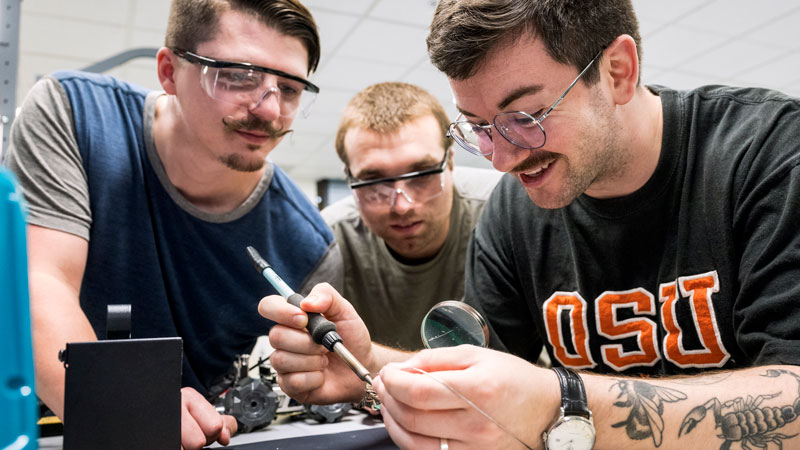
Professor Kathryn Higley (right), who teaches online and on-campus courses at Oregon State, is one of the go-to experts on the impacts of radiation, serving as a consultant for affected areas and offering guidance to governmental agencies in the aftermath of potentially hazardous events.
Professor Kathryn Higley juggles teaching online with OSU Ecampus and evaluating contaminated sites
Any nuclear radiation disaster will raise important questions:
How will the incident affect surrounding communities? What are the health risks for the people who live there?
When Kathryn Higley, professor in Oregon State University’s School of Nuclear Science and Engineering, isn’t teaching online and on-campus courses, she answers those questions for the media and public safety officials.
Ensure the safe use of radiation
Challenge yourself and advance your career by enrolling in Oregon State University’s rigorous health physics program online, and learn firsthand from world-recognized radiation detection and protection professionals.
Learn more
She’s one of the go-to experts on the impacts of radiation, serving as a consultant for affected areas and offering guidance to governmental agencies in the aftermath of potentially hazardous events.
Because Kathryn may be anywhere across the globe at any given time, it makes sense that she has taught mostly online courses in recent years as part of Oregon State’s radiation health physics master’s program, which is delivered online by OSU Ecampus. Her day-to-day schedule varies, she says, so the flexibility of the online format benefits her and her students alike.
“That’s kind of a nice thing – if I can get online, I can go in and make comments and grade things even if I’m half a world away,” she says.
Around the world
The Oregon resident’s career has taken her to places ranging from Washington state – the location of the Hanford Nuclear Reservation, where she once worked as a physicist – to the Fukushima Daiichi Nuclear Power Plant in Japan, the site of the well-publicized nuclear accident in 2011 prompted by an earthquake and tsunami.
Kathryn’s travels require a careful analysis of the safety risks beforehand. This year, she went to Paris to collaborate with a nuclear group to analyze data on the implications of radiation exposure for organisms.
Last year, she was brought to the former shipyard at Hunters Point outside of San Francisco, which for decades was the site of the U.S. Naval Radiological Defense Laboratory. After the environmental contractor overseeing the cleanup of radioactive waste at the site was accused of falsifying data, Kathryn was called in to clarify the potential risks.
“I work with people in the international community to try and develop tools to better understand radiation dose to nonhuman organisms,” she says. For the past two decades, she has focused more on the environmental rather than human risks of radiation, though she has focused on both in the course of her career.
“The common thread is understanding how radioactive materials released from either routine or accidental events can move through the environment.”
Kathryn plays a unique role after nuclear incidents because federal radiation protection agencies often can’t provide much information to the public, she says. So when the news media need an expert opinion, she provides a critical voice.
“The common thread is understanding how radioactive materials released from either routine or accidental events can move through the environment,” potentially impacting plants and animals and sometimes people, she says.

Kathryn plays a unique role after nuclear incidents because federal radiation protection agencies often can’t provide much information to the public, she says. So when the news media need an expert opinion, she provides a critical voice.
She adds that radiation health touches many areas of our world – whether in medical imaging, space travel, environmental protection or the overall safety of humankind.
Sharing a wealth of knowledge
Kathryn’s passion for radiation protection and health physics began during her undergraduate years at Reed College, when she started working at a reactor during a winter break. Now she serves as a professor at OSU, teaching classes on radiation biology and radiation ecology.
Kathryn’s online students are often adults with a mix of professional backgrounds; they may work in nuclear plants, hospitals, the military and government roles. Many pursue a degree to advance their careers, taking courses in topics including radiation detection, radiochemistry, and nuclear rules and regulations.
After earning her Ph.D. from Colorado State University, Kathryn came on board as an OSU faculty member in 1994 – a career move she had always wanted to make.
Having taught in person and online, she’s familiar with both formats. But, she says, prospective students shouldn’t expect a less rigorous course load just because a program is online. Ecampus students even complete group projects, just as they would in a face-to-face setting.
“There’s an expectation that you’re continually engaging with the material, with your peers, with the instructor, to keep you up to speed. And so you need to take [online learning] seriously.”
“There’s an expectation that you’re continually engaging with the material, with your peers, with the instructor, to keep you up to speed,” she says. “And so you need to take it seriously.”
Now it’s up to Kathryn – and her students – to address some of the significant radiation issues of today. This includes finding the right level of protection for affected communities without overzealously cleaning and causing damage.
“We’re still kind of arguing about where that appropriate level of protection sits. You want to get it right,” Kathryn says. “You want to make sure that your environment doesn’t pose a hazard to anybody, but you don’t destroy it at the same time.”





